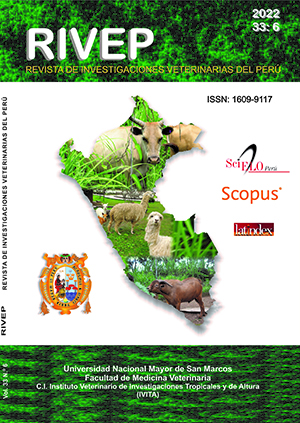Characteristics of alpaca fibre in the dry agroecological zone in the Peruvian highlands
DOI:
https://doi.org/10.15381/rivep.v33i6.22401Keywords:
alpaca, fibre characteristics, age, OFDAAbstract
The aim of this study was to evaluate the main physical characteristics and correlations of fibre diameter (FD), coefficient of variation (CVFD), comfort factor (CF) and itching factor (IF) of alpaca fibre in the dry agroecological zone of the Puno region, Peru. In total, 14 068 fibre samples were collected and analysed with the OFDA 2000 equipment. The factors sex (male, female), breed (Suri, Huacaya), age (DL: milk teeth; 2 DL: two teeth; 4D: four teeth; BLL: full mouth) and province (Melgar, Chucuito, Puno, El Collao, Lampa, San Román) through a factorial arrangement of 2×2×4×6 was evaluated. The FD was influenced by age, sex, breed and province (p<0.01), being smaller in alpacas DL (20.10 μm) and thicker in BLL (23.29 μm). In males it was 21.25 μm and in females 21.91 μm (p<0.05) and in Huacaya alpacas 21.25 μm and in Suri 22.21 μm (p<0.05). The CVFD and IF variables varied according to age, sex, breed and province (p<0.01), as did the CF, except for sex. The FD and FC showed (r=-0.89) high and negative correlation and the FD with CVFD had a low and negative correlation (r=-0.11). The IF and CF correlations were negative and high (r=-0.67). Alpacas from the dry agroecological zone of the Puno region produce good quality fibre with good potential for genetic improvement.
Downloads
Downloads
Published
Issue
Section
License
Copyright (c) 2022 Julio Málaga Apaza, Ali William Canaza Cayo, William Yana Viveros, Uri Harold Pérez Guerra, Francisco Halley Rodríguez Huanca

This work is licensed under a Creative Commons Attribution 4.0 International License.
AUTHORS RETAIN THEIR RIGHTS:
a. Authors retain their trade mark rights and patent, and also on any process or procedure described in the article.
b. Authors retain their right to share, copy, distribute, perform and publicly communicate their article (eg, to place their article in an institutional repository or publish it in a book), with an acknowledgment of its initial publication in the Revista de Investigaciones Veterinarias del Perú (RIVEP).
c. Authors retain theirs right to make a subsequent publication of their work, to use the article or any part thereof (eg a compilation of his papers, lecture notes, thesis, or a book), always indicating the source of publication (the originator of the work, journal, volume, number and date).










